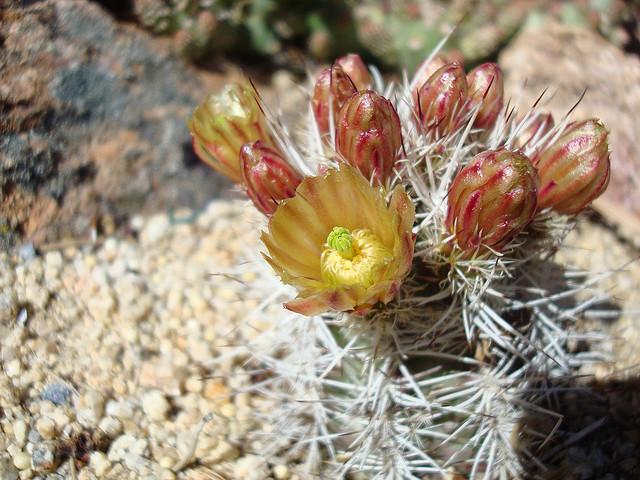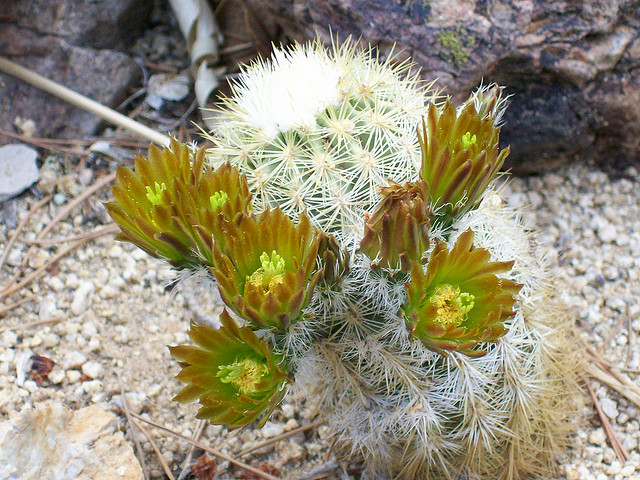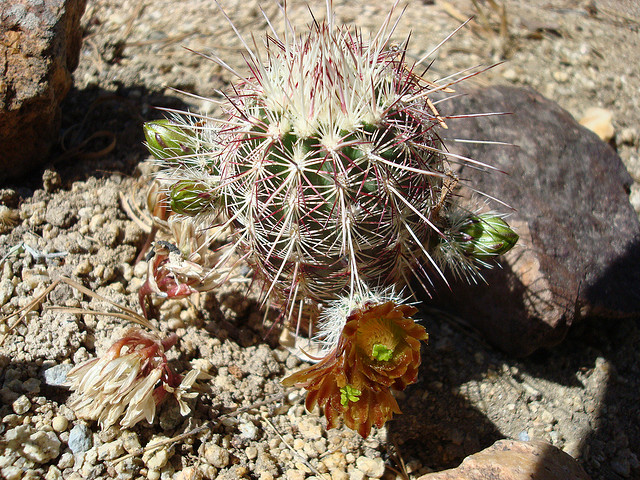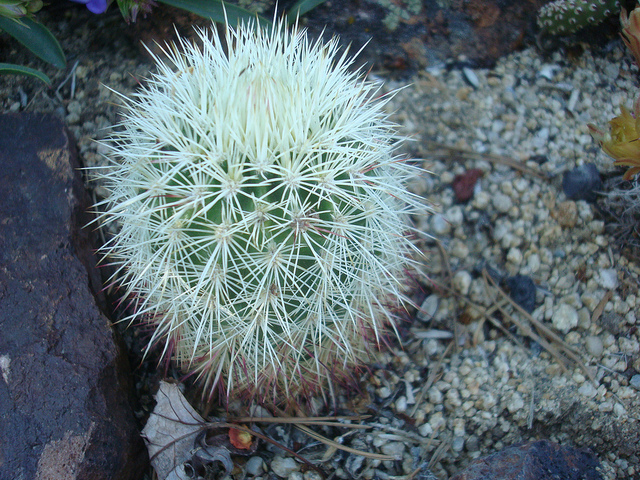There are quite a few varieties of Echinocereus viridiflorus that show at least some degree of hardiness. Echinocereus viridiflorus var. viridiflorus being the hardyest. It can be found as far north as south western, South Dakota. It follows the front range of the Rockies south into Texas and New Mexico. The other varieties come from west Texas and eastern New Mexico.
The taxonomy is in flux (a muddle) with Echinocereus russanthus being given species standing recently, that could change again as it has in the past. :rolleyes:
Here are the varieties I am able to grow.
1 Echinocereus viridiflorus var. viridiflorus
2 Echinocereus viridiflorus var. davisii
3 Echinocereus viridiflorus var. corellii
4 Echinocereus viridiflorus ssp. cylindricus
5 Echinocereus russanthus






Comments
Mark McDonough
Re: Echinocereus viridiflorus-complex
Fri, 12/03/2010 - 8:32pmWow! I might even make an exception to my "no growing plants with thorns" rule with the first one (all are nice), 1 Echinocereus viridiflorus var. viridiflorus, with those cherry red spines, like a little Christmas ball. :D
John P. Weiser
Re: Echinocereus viridiflorus-complex
Fri, 12/03/2010 - 8:45pmMark
It would be your best bet for success. They are charming and never get very large. With time they will form multi-headed clusters.
I am partial to Echinocereus viridiflorus var. cylindricus. The flowers in the picture do not do it justice. They are what I would term Rootbeer colored.
Here is a close up of var. cylindricus.
Mark McDonough
Re: Echinocereus viridiflorus-complex
Mon, 12/06/2010 - 10:33amIntriguing flower color indeed, "root beer barrels" of thorniness. I see from your first photo of this one, there are some red spines too, but the large white spines look ARMED AND DANGEROUS :D
Trond Hoy
Re: Echinocereus viridiflorus-complex
Mon, 12/06/2010 - 11:21amI somehow missed this one!
I remember growing some Echinocereus in my boyhood but they never had flowers with such subtle colors! Very charming and elegant.
WimB (not verified)
Re: Echinocereus viridiflorus-complex
Tue, 05/03/2011 - 5:44amEchinocereus viridiflorus growing here since 4 years unprotected outdoors and flowering for the third year in a row.
John P. Weiser
Re: Echinocereus viridiflorus-complex
Tue, 05/03/2011 - 5:58amYou got a happy little plant there! ;)
Mine are just budding up right now . I should have flowers in a day or two.
Trond Hoy
Re: Echinocereus viridiflorus-complex
Wed, 05/04/2011 - 4:53amWell, I have to try to get some more cacti to try in my climate, that's for sure!
John P. Weiser
Re: Echinocereus viridiflorus-complex
Sat, 05/14/2011 - 7:24amWell it's spring around here now and I have a couple of E. viridiflorus varieties coming into bloom. They are not at their peak yet but I can't resist posting a few shots.


Echinocereus viridiflorus ssp. viridiflorus
Echinocereus viridiflorus ssp. cylindricus
The ssp.. cylindricus is a large speciman at ten inches(26cm) tall with three heads whereas the ssp. viridiflorus is only two inches(5cm) tall. Quite a differance in size.
DesertZone (not verified)
Re: Echinocereus viridiflorus-complex
Thu, 09/01/2011 - 7:59pmI bought this E viridiflorus and thought nothing about it until this thread and then I thought about the common name "green flowerd cactus".


John P. Weiser
Re: Echinocereus viridiflorus-complex
Thu, 09/01/2011 - 10:33pmThe two photos in your posting look like varieties of Echinocereus reichenbachii to me.
I will venture a couple of guesses . Echinocereus reichenbachii ssp. reichenbachii for the first and Echinocereus reichenbachii ssp. armatus for the second. They could be any of several other varieties however. There are no definite clearcut divisions in this species and a lot of integration across it's range.
Look at the Echinocereus reichenbachii complex posting about this species.
http://nargs.org/smf/index.php?topic=501.0
DesertZone (not verified)
Re: Echinocereus viridiflorus-complex
Fri, 09/02/2011 - 11:53amThanks Weiser
Andy71 (not verified)
Re: Echinocereus viridiflorus-complex
Sun, 04/29/2012 - 4:29pmIn the garden today viridiflorus var. viridiflorus. Very early, first bloom was May 26 last year.
Several of my own seedlings are going to bloom for the first time too
Richard T. Rodich
Re: Echinocereus viridiflorus-complex
Sun, 04/29/2012 - 4:40pmWhy do all those buds ( :o) make me think of Christmas lights? Even the open flower makes me reminisce of similar old reflectors we use on the tree as a kid.
Bravo, Andy!
Are those self seeded little balls at the base of the plant?
Andy71 (not verified)
Re: Echinocereus viridiflorus-complex
Sun, 04/29/2012 - 5:20pmThey are! Surprised me when I first noticed them earlier this year. The plant has never made a fruit, the old buds always just dried up. I never sprinkled any there so it must have made a few
John P. Weiser
Re: Echinocereus viridiflorus-complex
Mon, 04/30/2012 - 7:02amSneaky little devils! ;)
I wonder if the seed was in the soil when you planted the large plant. They could be siblings rater than progeny.
Andy71 (not verified)
Re: Echinocereus viridiflorus-complex
Mon, 04/30/2012 - 11:47amThis plant came completely bare root but it is possible a seed or two were in the roots? Seems more likely ,based on where they are, the plant managed to make a few seeds without a true fruit.
Either way I feel like a proud poppa! My own seedlings are definitely a different clone so I may get some real seed pods this year.
John P. Weiser
Re: Echinocereus viridiflorus-complex
Wed, 05/16/2012 - 12:19pmHere are a few shots of Echinocereus viridiflorus ssp. cylindricus blooming this spring. I never know what to call the flower color on these. Brown? Bronze? Brassy? I finally settled on Root Beer Colored! :)
Andy71 (not verified)
Re: Echinocereus viridiflorus-complex
Mon, 05/21/2012 - 8:29amCertainly is a strange color. I will have to try some of the other viridiflorus varieties someday. Too busy growing an army of the base form.
My own seedlings are starting to bloom at 3 years
[attachment=1]
DesertZone (not verified)
Re: Echinocereus viridiflorus-complex
Mon, 05/21/2012 - 4:55pmNice!
Richard T. Rodich
Re: Echinocereus viridiflorus-complex
Mon, 05/21/2012 - 8:14pmI am very impressed.
So this is not a fluke that something so small is already blooming?
Trond Hoy
Re: Echinocereus viridiflorus-complex
Tue, 05/22/2012 - 2:46amHow do I know that it is a small coin ??? ;)
Andy71 (not verified)
Re: Echinocereus viridiflorus-complex
Tue, 05/22/2012 - 5:03am3 of 9 all similar in size put out a single bloom so I guess not a fluke. They were planted in the garden last spring so they have gone one winter unprotected. Here's another (I promise it is a different one 8) )
[attachment=1]
John P. Weiser
Re: Echinocereus viridiflorus-complex
Tue, 05/22/2012 - 5:56amIt may be differant but you can still see the family resemblance. ;D
Richard T. Rodich
Re: Echinocereus viridiflorus-complex
Tue, 05/22/2012 - 6:38amIt's quite a wonderment to me.
Congratulations! :o
John P. Weiser
Re: Echinocereus viridiflorus-complex
Tue, 05/22/2012 - 9:27amRick
A grower in Reno has had a few Escobaria vivpara do the same thing! Bloom on three year old seedlings. They may be nickle sized plants. He had them growing in an unheated green house. It surprised me too at the time!!